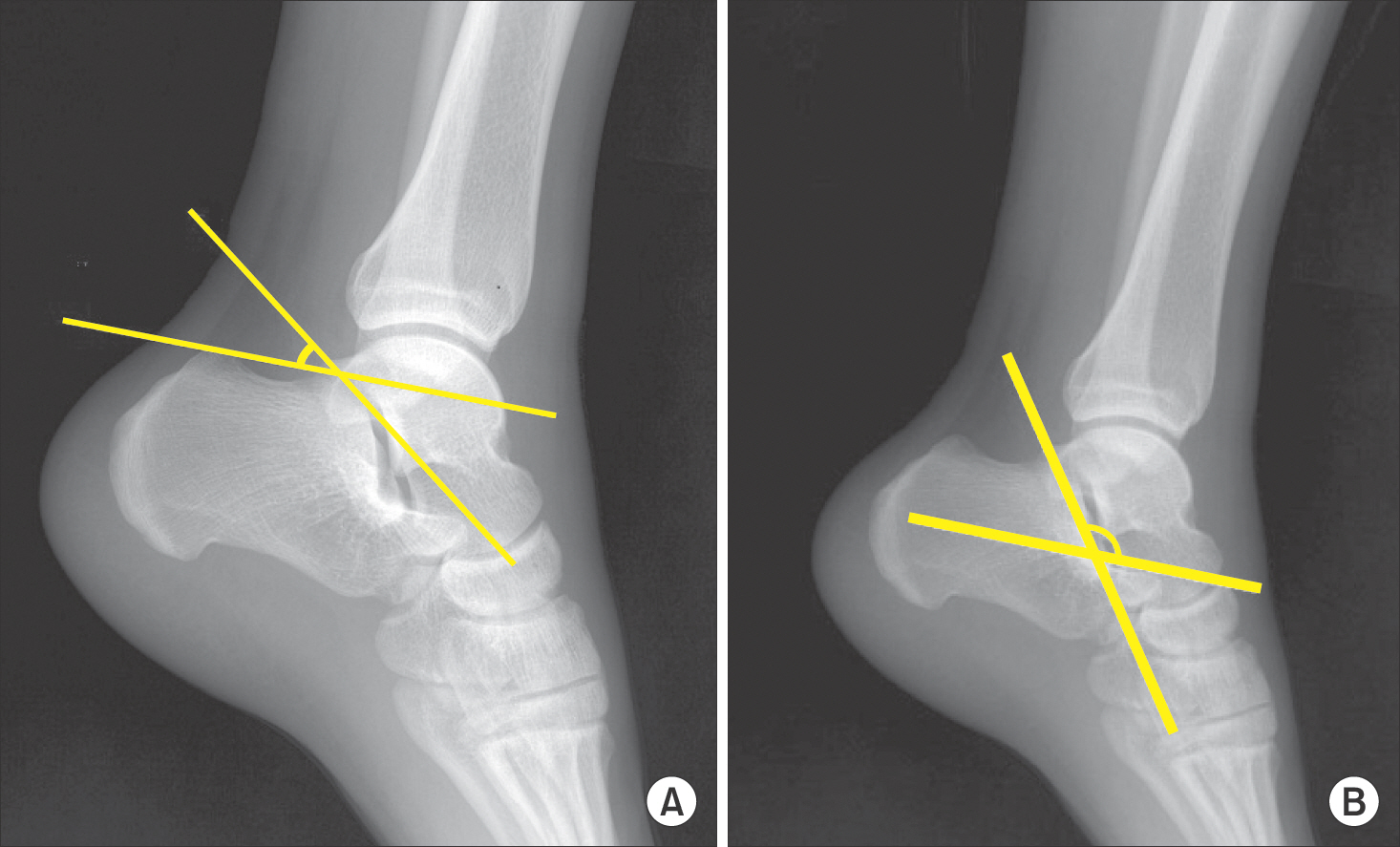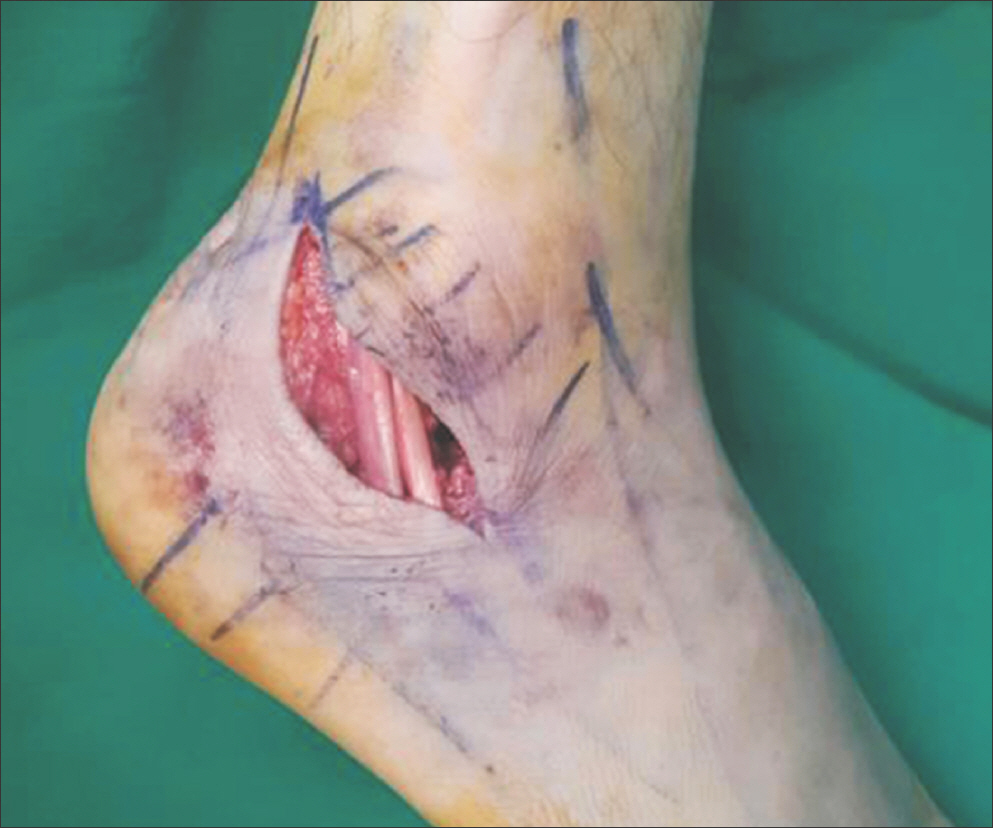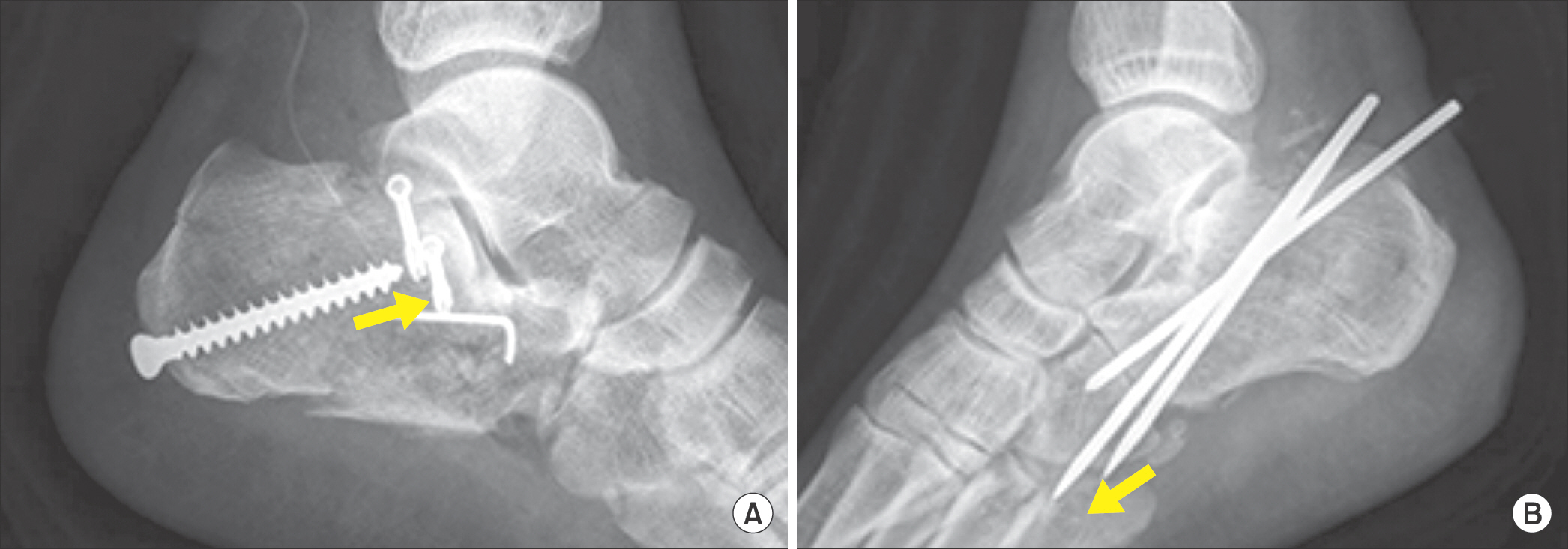J Korean Foot Ankle Soc.
2015 Mar;19(1):11-17. 10.14193/jkfas.2015.19.1.11.
Usefulness of Treatment with 6.5 mm Cancellous Screw and Steinmann Pin Fixation for Calcaneal Joint Depression Fracture
- Affiliations
-
- 1Department of Orthopedic Surgery, Chungnam National University School of Medicine, Daejeon, Korea. faschan@daum.net
- 2Department of Orthopedic Surgery, Konyang University College of Medicine, Daejeon, Korea.
- KMID: 1958699
- DOI: http://doi.org/10.14193/jkfas.2015.19.1.11
Abstract
- PURPOSE
To report the radiographic and clinical results of 6.5 mm cancellous full threaded buttress screw or Steinmann pin fixation to maintain a reduction of calcaneal posterior facet depression fracture.
MATERIALS AND METHODS
From June 2009 to June 2012, 50 consecutive cases with calcaneal joint depression fracture that underwent open reduction and screw or pin fixation were enrolled in this study. A 6.5 mm cancellous full threaded screw was inserted from the posteroinferior aspect of the calcaneal tuberosity to the posterior facet (group A) or Steinman pin was inserted from the posterosuperior aspect of the calcaneal tuberosity to the calcaneocuboidal joint (group B). Both preoperative and postoperative Bohler and Gissane angles were measured radiographically, and American Orthopaedic Foot and Ankle Society (AOFAS) ankle-hindfoot scale on the final follow-up were assessed.
RESULTS
The mean age of patients was 44.1 years, and the mean follow-up period was 27.2 months. According to the Sanders classification, 28 cases were type II and 22 cases were type III. In Sanders type II, Bohler and Gissane angles improved significantly from 10.1degrees and 126.2degrees preoperatively to 27.2degrees and 117.1degrees, respectively, in the immediate postoperative radiograph, and at the final follow-up, 26.6degrees and 118.6degrees, respectively. In Sanders type III, Bohler and Gissane angles improved significantly from 5.0degrees and 129.8degrees to 29.9degrees and 119.3degrees, respectively, in the immediate postoperative radiograph, and 26.9degrees and 120.2degrees at the final follow-up. All cases achieved bony union, and the average period until complete union was 13.3 weeks. AOFAS ankle-hindfoot scale was 82.6 in Sanders type II and 77.3 in Sanders type III at the final follow-up.
CONCLUSION
A 6.5 mm cancellous full threaded buttress screw or Steinman pin fixation is a noninvasive treatment method with a merit of being able to maintain the bearing capacity of the posterior facet comparable to plate fixation.
MeSH Terms
Figure
Reference
-
1.Cave EF. Fracture of the os calcis--the problem in general. Clin Orthop Relat Res. 1963. 30:64–6.2.Fitzgibbons TC., McMullen ST., Mormino MA. Fractures and dislocations of the calcaneus. Bucholz RW, editor. editor.Rockwood and Green’s factures in adults. 5th ed.Philadelphia: Lippincott Williams & Wilkins;2001. p. 2133–79.3.Murphy GA. Fractures and dislocations of foot. Canale ST, Campbell WC, editors. editors.Campbell’s operative orthopaedics. 10th ed.St. Louis: Mosby;2003. p. 4231–83.4.Tscherne H., Schatzker J. Major fractures of the pilon, the talus and the calcaneus: current concepts of treatment. Berlin: Springer-Verlag;1993. p. 153–74.5.Abidi NA., Dhawan S., Gruen GS., Vogt MT., Conti SF. Wound-healing risk factors after open reduction and internal fixation of calcaneal fractures. Foot Ankle Int. 1998. 19:856–61.
Article6.Benirschke SK., Sangeorzan BJ. Extensive intraarticular fractures of the foot. Surgical management of calcaneal fractures. Clin Orthop Relat Res. 1993. 292:128–34.7.Barei DP., Bellabarba C., Sangeorzan BJ., Benirschke SK. Fractures of the calcaneus. Orthop Clin North Am. 2002. 33:263–85.
Article8.Stephenson JR. Surgical treatment of displaced intraarticular fractures of the calcaneus. A combined lateral and medial ap-proach. Clin Orthop Relat Res. 1993. 290:68–75.9.Essex-Lopresti P. The mechanism, reduction technique, and results in fractures of the os calcis. Br J Surg. 1952. 39:395–419.
Article10.Letournel E. Open reduction and internal fixation of calcaneus fractures. Spiegel PG, editor. editor.Topics in orthopedic trauma. 1st ed.Baltimore: University Parkpress;1984. p. 173–92.11.Letournel E. Open treatment of acute calcaneal fractures. Clin Orthop Relat Res. 1993. 290:60–7.
Article12.Zwipp H., Tscherne H., Thermann H., Weber T. Osteosynthesis of displaced intraarticular fractures of the calcaneus. Results in 123 cases. Clin Orthop Relat Res. 1993. 290:76–86.13.Sanders R., Fortin P., DiPasquale T., Walling A. Operative treatment in 120 displaced intraarticular calcaneal fractures. Results using a prognostic computed tomography scan classification. Clin Orthop Relat Res. 1993. 290:87–95.14.Ross SD., Sowerby MR. The operative treatment of fractures of the os calcis. Clin Orthop Relat Res. 1985. 199:132–43.
Article15.Thordarson DB., Krieger LE. Operative vs. nonoperative treatment of intra-articular fractures of the calcaneus: a prospective randomized trial. Foot Ankle Int. 1996. 17:2–9.
Article16.Basile A. Operative versus nonoperative treatment of displaced intra-articular calcaneal fractures in elderly patients. J Foot Ankle Surg. 2010. 49:25–32.
Article17.Robb CA., Deans V., Iqbal MJ., Cooper JP. Comparison of non-operative and surgical treatment of displaced calcaneal fractures. The Foot. 2007. 17:169–73.
Article18.Palmer I. The mechanism and treatment of fractures of the calcaneus; open reduction with the use of cancellous grafts. J Bone Joint Surg Am. 1948. 30:2–8.19.Maxfield JE., McDermott FJ. Experiences with the Palmer open reduction of fractures of the calcaneus. J Bone Joint Surg Am. 1955. 37:99–106.
Article20.McReynold IS. The case on operative treatment of the os calcis. Leach RE, Hoaglund FT, Riseborough EJ, editors. editors.Controversies in orthopedic surgery. Philadelphia: Sanders;1982. p. 232–54.21.Levine DS., Helfet DL. An introduction to the minimally invasive osteosynthesis of intra-articular calcaneal fractures. Injury. 2001. 32(Suppl 1):SA51-4.
Article22.Schepers T., Schipper IB., Vogels LM., Ginai AZ., Mulder PG., Heetveld MJ, et al. Percutaneous treatment of displaced intra-articular calcaneal fractures. J Orthop Sci. 2007. 12:22–7.
Article23.Widen A. Fractures of the calcaneus: a clinical study with special reference to the technique and results of open reduction. Acta Chir Scand Suppl. 1954. 188:1–119.24.Lee MJ., Sohn SK., Lee KY., Kim SS., Kang MS., Kim HJ, et al. Open reduction and internal fixation with AO calcaneal plate for displaced intra-articular calcaneal fracture. J Korean Fract Soc. 2010. 23:303–9.
Article25.Moon JS., Lee WC. A comparison of extensile lateral approach and sinus tarsi approach for the sanders type II calcaneal fracture. J Korean Fract Soc. 2009. 22:13–8.
Article26.Lee YT., Oh HC., Yoon HK., Jang JW., Jang KJ. Comparison of F calcaneal plate and locking calcaneal plate fixation using an lateral extensile approach to intra-articular calcaneal fractures. J Korean Foot Ankle Soc. 2012. 16:175–80.
- Full Text Links
- Actions
-
Cited
- CITED
-
- Close
- Share
- Similar articles
-
- Comparison of Bending Strength among Plate, Steinmann Pin, and Headless Compression Screw Fixations for Proximal Ulnar Shaft Fracture in Sawbones
- Avulsion Fracture of Calcaneal Tubercle Treated with Cannulated Cancellous Screws and Wire: Surgical Technique
- Steinmann Pin Assisted Reduction of Subtrochanteric Femoral Fracture
- Operative Treatment of Clavicle Fracture
- The Result of Closed Reduction and Percutaneous Screw Fixation for Intra-articular Calcaneal Fracture of Joint Depression Type




